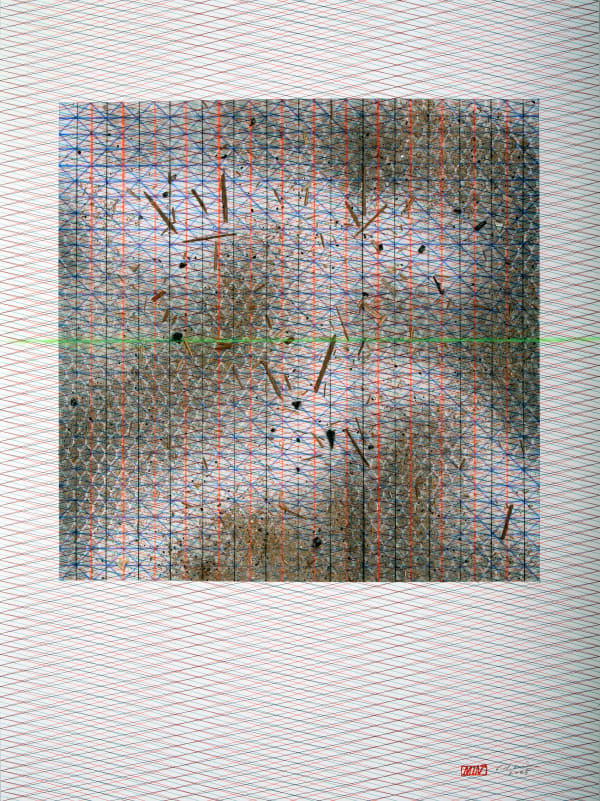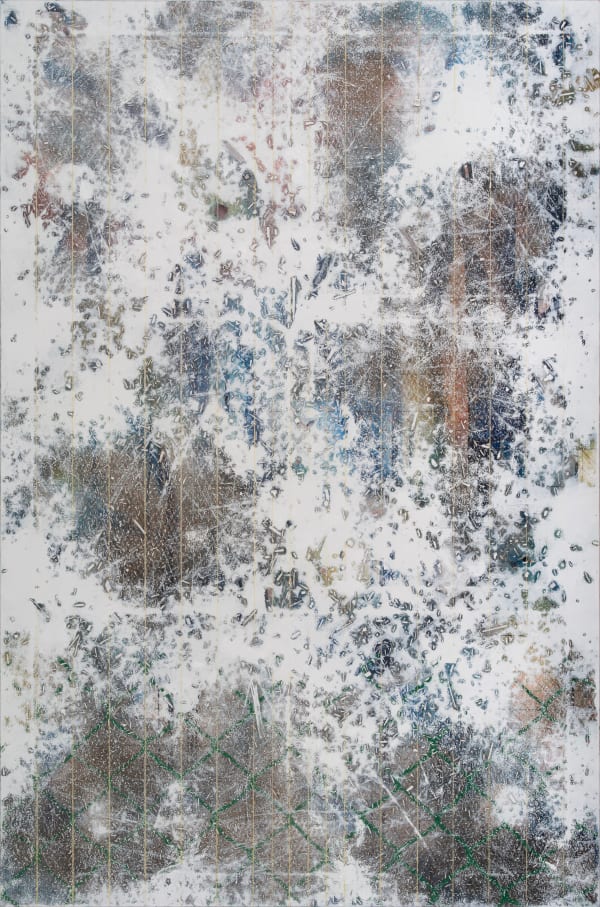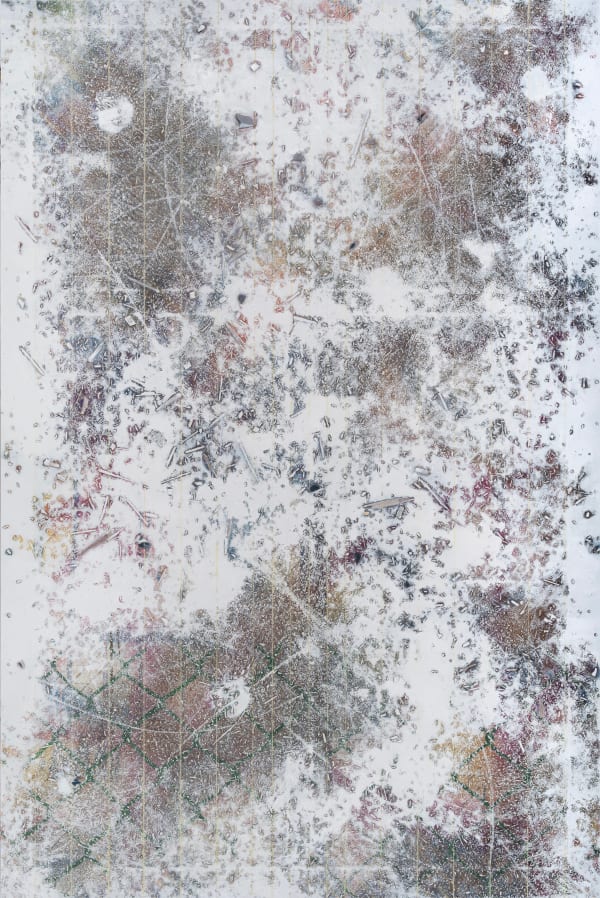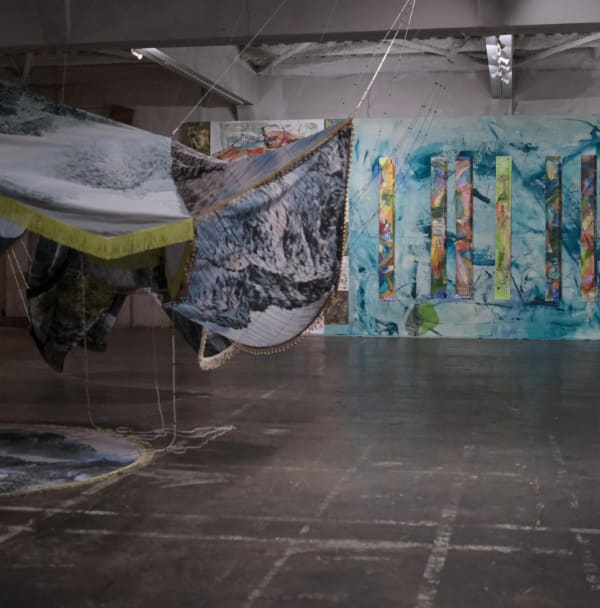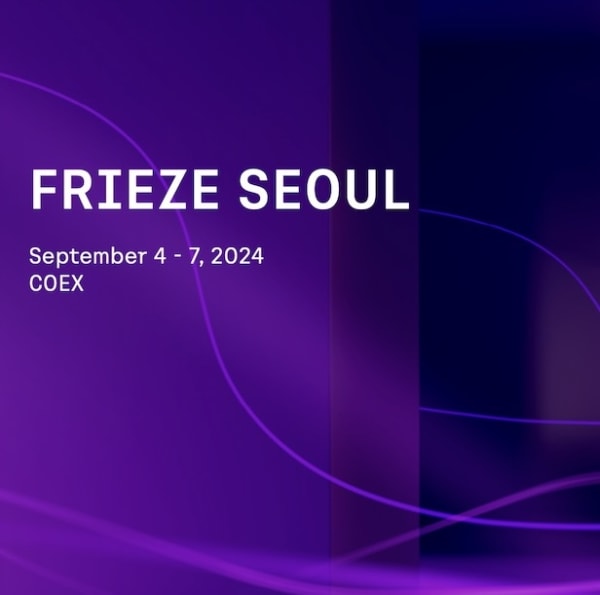Flow of Debris: 파편의 흐름
-
Time of Debris by Min-ju Lee (Art Critic)
Flow of Debris speaks of transient objects that refuse to stay still or drift but soon become accumulated. Seonghong Min focuses on relationships that have long been invisible yet clearly connected. He collects and rearranges old furniture, discarded landscaping paintings, fractured scenic murals, and shattered objects exploring a landscape of contradictory imagery: dispersion and overlap, and connection and suspension. In line with this context, the exhibition tracks mobility of ‘flow and sedimentation.’ The artist pays attention to objects that bear anxiety and various feelings sensed amid uncontrollable environmental changes caused by social institutions and systems. Primarily, he begins with furniture, objects, and items that were left behind by people and no longer functioning. In his hands, these pieces lose their forms, become fragmented, and are reassembled. Through this process, he observes how an object constructs space and generates a new landscape. This exhibition rakes up the fragments of objects and explores new connections among these debris. In this exhibition especially, Seonghong Min, known for working with objects and formative language of installation, examines points of connection between fragmented items presenting his series of paintings after a decade. The series transforms collected items from various places into installations, sculptures, and paintings in his formative language. Physically broken down by a woodchipper, the objects are reduced into smaller pieces and organically link the divided space: the underground and the ground level. The underground space showcases transformable installations and large-scale paintings that stress the spatiality and gathering of objects from different locations. Above ground, paintings with rough surfaces unfold on the grid like a single landscape suggesting an experiment with spatial scale.
-
work on paper
-
Circulating Body_Antenna Bird (2025) is sculpted in the form of a body as an installation combining ‘a crystal radio.’ This artwork captures ambient radio waves and converts them into sound without using electricity. It functions as both a technological and metaphorical device that mediates a flow emitted from elsewhere yet not clearly perceived or signals lingering in the blank space of the senses. Min explored invisible flows within the intricate network of relationships that bind individuals, groups and society and examined the sensations that deviate from those flows. In Circulating Body_Antenna Bird (2025), he transforms objects into an embodied antenna and transmits his accumulated concepts to an invisible medium, ‘electric wave.’ The reconfigured antenna object emerges not as a fixed structure but a circulating assembly that expands and transforms organically depending on the spatial environment, and it reveals a responsive structure that experiments possibility of connection between inside and outside, me and others. For Seonghong Min, the medium ‘electric wave’ is neither merely a flow of immaterial information nor an electronic device. As Finnish media theorist, Jussi Ville Tuomas Parikka, argues that media is rooted in geological resources, time and elemental matters, Min interprets electric waves as sensory waves beneath layers of Earth or fragmented temporality of invisible flows. To rephrase: antennas or objects integrated with a crystal radio transcend their role as receivers. They oscillate among body, technology, recollection and environment, and become an expanded body mediating imperceptible time and history. His paintings capture this geological temporality.
[1] Jussi Ville Tuomas Parikka argues that the resources composing media devices are grounded in Earth’s geological strata. According to him, media theory engages with how humans consider temporarily. Jussi Parikka, Geology of Media, trans. Jumin Park (Seoul: Hyunsil Book, 2019), pp. 33
-
work on canvas
-
Min’s new painting series are divided into Exercise for Drawing and Exercise for Painting. In Exercise for Drawing, ground object fragments are scattered across a flat surface divided by lines with colorful ballpoint pens and chalk powder. Typically used to mark boundaries in construction or woodworking, the chalk powder here functions as baseline for determining locations of structures or boundaries or division. On the canvas, the chalk powder becomes a medium that expresses administrative and institutional frameworks metaphorically, and the consequent unfolded landscape operates as a fluid and uncertain sensory terrain. Disorderly debris positioned on the segmented canvas imply spaces once occupied by beings that withdrew from or were excluded from the social sphere or the community. In Exercise for Drawing_Fleck (2025) specifically, a laser level cuts across the center of the frame evoking the image of a polaroid. While a laser level typically serves to ‘balance’ and partition space, Min’s lines arrange separate drawings within a grid and link them side by side, forming an image of flow, rather than disconnection.
-
Meanwhile, in Exercise for Painting, object fragmentsare condensed and layered onto the canvas. This is not merely a product of physical arrangement. It displays a process where debris of objects builds up onto the crust-like layers. That surface is never flat. Beneath the roller-applied paint, fragments rise like reliefs, then the surface becomes three-dimensional again. The uneven canvas invites viewers to read and rearrange shattered cues. Like an archaeologist analyzes sedimentary strata, Min reconstructs aspects of time by arranging fragments from the other space and times into a single screen. Traces that overlap and fold on the surface and forms that are repeatedly painted and concealed reveal how time embedded in a single object flows iteratively: it moves, folds, pauses, and accumulates again. As the way time permeates an object resembles the process of sedimentation, the artist questions the time accumulated within it and the new temporality it encounters once it departs from its place.
This insight arises from his understanding that layers of time are constructed in tandem with the movement of space. For that reason, shredded fragments or debris in his work are not remnants of destruction or violence but symbolize imagery of migration and displacement. To him, displacement does not signify physical movement or loss of place. That points out the issue of sensory rupture, where an object that has lost its function slips out of its relationships with place or people. In other words, Seonghong Min’s debris is not simply scraps but embraces the sensory tension born from its separation from the space and time it once shared with humans. In that context, for Min, paintings are neither about creating a single image on a canvas nor culminating in the traditional formative form. Rather, they are a single object accumulated and condensed through objects and senses, and recollection and feelings, and the residue of layered time and materials.
the sediment of objects rather than scattered fragments. Amid the mobility of flux of debris, he observes how traces of migration and movement accumulated and form a new layer and sensory terrain. To Min, today’s migration extends beyond border-crossing or physical transition driven by war, climate disasters, or economic instability. It is interwoven with complex aspects of identity, instability/uncertainty, setting boundaries, and a sense of belonging. This discloses a way of life that is continually suspended and deferred from the realm of social norms and standards; a life shaped by fluid conditions that resist being pinned down. Tracing the movements and accumulation of disassembled and crumbled remnants of once complete forms, Seonghong Min is drawing a political topography of drifting objects that failed to be detected in an institutional language.
-
-
previous episode
-

Seeming of Seeming
민성홍 19 May - 1 Jul 2022The body is a living form made from the reshaped experiences of people and nature. The structures and outside forces around it cover or decorate it like a mask. Its... -

ART OSAKA 2024 Expanded Section
18 - 22 Jul 2024 -

Frieze Seoul 2024
Booth C10 4 - 7 Sep 2024 -

As the Sharp Narrative Fades, A Revealing Map Emerges (Part1)
Alternating exhibition of Korea and France 28 Feb - 6 Apr 2024As the Sharp Narrative Fades, A Revealing Map Emerges (Part 1) Exchange program between gallerychosun X Le Wonder 2024.2.28 - 4.6 gallerychosun gallerychosun hosts its exchange exhibition with Le Wonder... -

경기작가 2024 민성홍
경기도미술관2024.7.11 - 9.22 4전시실
-


